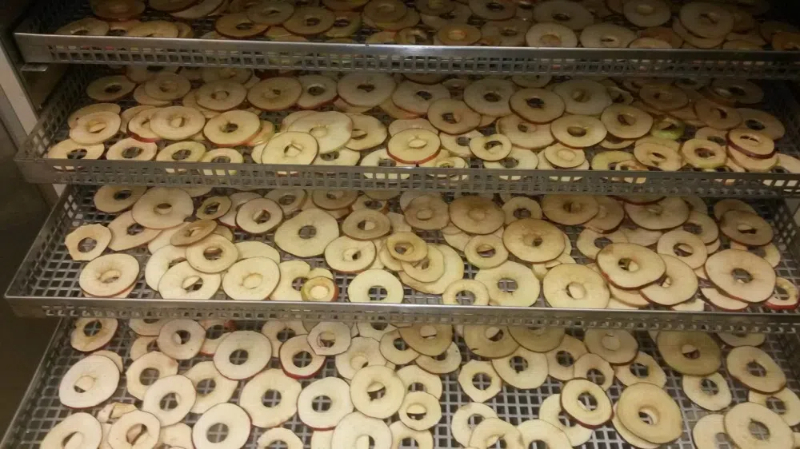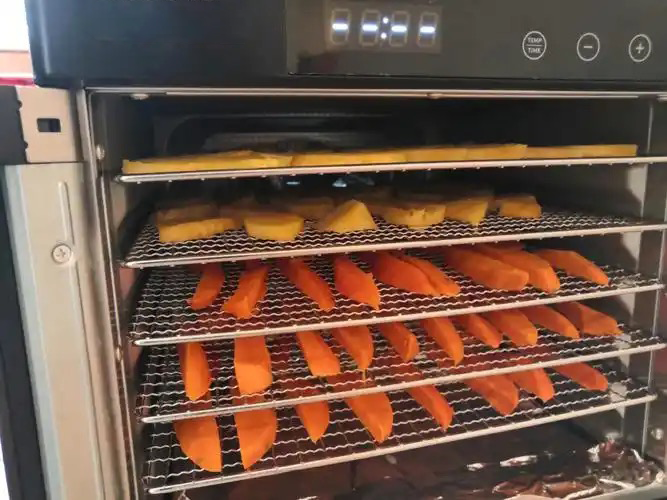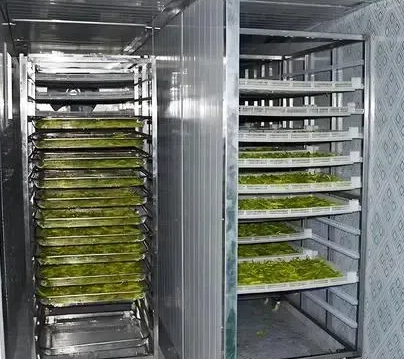
Content Menu
● Introduction
● What is a Cabinet Dryer?
● Advantages of Cabinet Dryers
● Diverse Applications in Food Processing
● The Rise of OEM Services in Food Drying
>> Benefits of OEM for Your Factory
● Key Features to Highlight in Your OEM Cabinet Dryers
● Integrating Technology for Enhanced Performance
● Energy Efficiency and Sustainable Practices
● Cost Considerations and ROI
● Case Studies and Success Stories
● Detailed Look at Different Types of Cabinet Dryers
● Maintenance and Longevity of Cabinet Dryers
● Case Study: Implementing Cabinet Dryers in a Large-Scale Food Processing Plant
● Future Trends in Food Drying Technology
● Conclusion
● FAQ
>> 1. What types of food can be dried in a cabinet dryer?
>> 2. How energy-efficient are cabinet dryers compared to other drying methods?
>> 3. What are the key features to look for in a high-quality cabinet dryer?
>> 4. Can cabinet dryers be customized to meet specific production needs?
>> 5. What is the return on investment (ROI) for investing in a cabinet dryer?
● Citations:
Introduction
In the dynamic and competitive food industry, businesses are continuously seeking methods to optimize processes, extend product shelf life, and meet the escalating demand for superior dried goods. Efficiency, quality, and cost-effectiveness are the cornerstones of success. Cabinet dryers, also known as cabinet dehydrators, represent a smart investment for businesses of all sizes, offering a blend of versatility, precision, and energy efficiency. This article explores the multifaceted advantages of cabinet dryers, their diverse applications in food processing, and why they represent an excellent choice for Original Equipment Manufacturer (OEM) services.

What is a Cabinet Dryer?
A cabinet dryer is a self-contained unit engineered to eliminate moisture from food products through the regulated circulation of heated air. It comprises an insulated cabinet housing trays or shelves that accommodate food items. A heating system, typically powered by electricity or gas, warms the air, while fans ensure the even distribution of hot air throughout the cabinet. This systematic process gradually diminishes the moisture content of the food, thereby preserving it for extended periods.
Advantages of Cabinet Dryers
Cabinet dryers proffer numerous key advantages, rendering them a worthwhile investment for food businesses:
- Versatility: Cabinet dryers can process a vast array of food products, encompassing fruits, vegetables, herbs, spices, meats, and seafood. Their adaptability makes them ideal for varied processing needs.
- Uniform Drying: The controlled environment within a cabinet dryer guarantees uniform drying, resulting in consistent product quality. This is crucial for preserving the desired texture, flavor, and appearance of dried foods.
- Energy Efficiency: Compared to other drying methodologies, cabinet dryers are comparatively energy-efficient. They minimize energy consumption while upholding optimal drying conditions.
- Customization: Cabinet dryers are available in a range of sizes and capacities, rendering them adaptable to differing production scales. Businesses can select a model that aligns with their specific output requirements.
- Affordability: The initial investment for a cabinet dryer is generally more economical than other industrial drying systems. This makes it accessible to small and medium-sized enterprises (SMEs).
- Precise Control: Industrial drying cabinets offer precise temperature and humidity control, which is essential for achieving consistent and high-quality results.
- Reduced Contamination Risk: The controlled environment diminishes the risk of contamination and spoilage, guaranteeing product safety and quality.
Diverse Applications in Food Processing
Cabinet dryers are utilized across diverse segments of the food processing industry:
- Fruits and Vegetables: Drying fruits and vegetables such as apples, bananas, berries, tomatoes, and peppers to create snacks, ingredients, or dehydrated meals.
- Herbs and Spices: Preserving herbs and spices like basil, oregano, rosemary, and chili peppers while retaining their flavor and aroma.
- Meats and Seafood: Producing jerky, biltong, dried fish, and other protein-rich snacks with extended shelf life.
- Snack Foods: Manufacturing dried fruit leather, vegetable chips, and other healthy snack options.
- Pet Foods: Creating dried meat and vegetable components for pet food formulations.
The Rise of OEM Services in Food Drying
Original Equipment Manufacturing (OEM) has evolved into a prevalent business model within the food processing equipment sector. OEM services entail a company (the OEM) manufacturing products under another company's brand name. For food dehydrators, this signifies that a factory such as yours produces cabinet dryers that are subsequently sold by foreign brands, wholesalers, and other manufacturers.
Benefits of OEM for Your Factory
- Increased Production Volume: Partnering with multiple brands and wholesalers can substantially augment your production volume, leading to economies of scale.
- Market Access: OEM partnerships furnish access to established markets and distribution networks that would otherwise be challenging to penetrate.
- Brand Recognition: While you manufacture the equipment, the branding is managed by your partners, enabling you to concentrate on manufacturing excellence.
- Reduced Marketing Costs: OEM agreements curtail the need for extensive marketing efforts, as your partners handle the promotion and sales aspects.
- Consistent Revenue Streams: Long-term OEM contracts can provide a consistent revenue stream, ensuring financial stability for your factory.
Key Features to Highlight in Your OEM Cabinet Dryers
When marketing your cabinet dryers for OEM services, emphasize the following features:
- Customization Options: Offer a range of customization options, encompassing size, capacity, heating systems (electric, gas, solar), control panels, and materials.
- Energy Efficiency: Accentuate the energy-saving features of your dryers, such as insulation, efficient heating elements, and optimized airflow.
- Advanced Control Systems: Showcase models with advanced temperature and humidity control systems, ensuring precise and consistent drying.
- Durability and Reliability: Employ high-quality materials and construction techniques to ensure long-term reliability and minimal maintenance.
- Compliance: Ensure your dryers meet international safety and hygiene standards, such as CE, UL, and NSF certifications.

Integrating Technology for Enhanced Performance
To remain competitive, contemplate integrating advanced technologies into your cabinet dryers:
- IoT Integration: Implement Internet of Things (IoT) sensors for real-time monitoring of temperature, humidity, and energy consumption. This data can be employed to optimize drying cycles and anticipate maintenance needs.
- Smart Controls: Develop user-friendly control panels with programmable drying cycles, remote monitoring, and automated adjustments.
- AI-Powered Optimization: Utilize artificial intelligence (AI) algorithms to analyze drying data and optimize settings for different food products, maximizing efficiency and quality.
Energy Efficiency and Sustainable Practices
Highlighting energy-efficient and sustainable practices can attract environmentally conscious buyers:
- Solar-Powered Models: Offer cabinet dryers that can be powered by solar energy, diminishing reliance on fossil fuels and lowering operating costs.
- Heat Recovery Systems: Implement heat recovery systems to capture and reuse waste heat, further improving energy efficiency.
- Eco-Friendly Materials: Utilize eco-friendly and recyclable materials in the construction of your dryers.
Cost Considerations and ROI
While the initial cost of a cabinet dryer is a significant factor, it's essential to consider the return on investment (ROI). Here's how cabinet dryers can offer substantial cost savings:
- Reduced Energy Consumption: Energy-efficient models can significantly lower electricity or gas bills.
- Lower Labor Costs: Automated drying cycles reduce the need for manual labor, lowering operational costs.
- Extended Shelf Life: Properly dried foods have a longer shelf life, reducing waste and increasing profitability.
- Consistent Product Quality: Uniform drying minimizes product defects and ensures customer satisfaction, leading to repeat business.
Case Studies and Success Stories
Including case studies and success stories can provide potential buyers with concrete evidence of the benefits of cabinet dryers:
- Small-Scale Farmer: A small-scale farmer increased their income by drying surplus fruits and vegetables using a cabinet dryer, selling them at a premium during the off-season.
- Snack Food Manufacturer: A snack food manufacturer improved the quality and consistency of their dried fruit snacks by switching to a cabinet dryer with advanced control systems.
- Meat Processing Plant: A meat processing plant reduced waste and improved the shelf life of their jerky products by implementing a cabinet drying system.
Detailed Look at Different Types of Cabinet Dryers
To provide a comprehensive understanding, let's delve into the various types of cabinet dryers available on the market:
Electric Cabinet Dryers: These are the most common type, utilizing electric heating elements to generate heat. They are typically easy to install and offer precise temperature control.
- Pros: Precise temperature control, easy to install, suitable for small to medium-scale operations.
- Cons: Can be more expensive to operate due to electricity costs, may require a dedicated electrical circuit.
Gas Cabinet Dryers: These dryers use natural gas or propane as a fuel source. They are often more energy-efficient for larger operations.
- Pros: Lower operating costs for large-scale operations, faster heating times.
- Cons: Requires gas line installation, may have higher upfront costs, requires proper ventilation.
Solar Cabinet Dryers: An environmentally friendly option that utilizes solar energy to heat the air. They can significantly reduce energy costs but depend on sunlight availability.
- Pros: Environmentally friendly, low operating costs, sustainable.
- Cons: Dependent on sunlight, may require supplemental heating for consistent operation.
Hybrid Cabinet Dryers: Combine two or more heating sources (e.g., electric and solar) to provide reliable and efficient drying.
- Pros: Versatile, reliable, combines the benefits of different heating sources.
- Cons: Higher initial cost, more complex system.
Maintenance and Longevity of Cabinet Dryers
Proper maintenance is crucial for ensuring the longevity and efficient operation of your cabinet dryers. Here are some key maintenance tips:
- Regular Cleaning: Clean the interior of the cabinet and trays regularly to remove food debris and prevent mold growth.
- Fan Maintenance: Inspect and clean the fans regularly to ensure proper airflow.
- Heating Element Inspection: Check the heating elements for signs of damage or wear and replace them as needed.
- Seal Inspection: Inspect the door seals to ensure they are airtight, preventing heat loss and maintaining consistent drying conditions.
- Calibration: Calibrate the temperature and humidity sensors regularly to ensure accurate readings.
Case Study: Implementing Cabinet Dryers in a Large-Scale Food Processing Plant
- Challenge: A large-scale food processing plant producing dried fruits and vegetables was facing challenges with inconsistent product quality and high energy costs. Their existing drying system was outdated and inefficient.
- Solution: The plant invested in a new cabinet drying system with advanced temperature and humidity controls. The new system also included energy-efficient heating elements and a heat recovery system.
Results:
- Improved Product Quality: The new cabinet dryers provided consistent and uniform drying, resulting in higher-quality dried fruits and vegetables.
- Reduced Energy Costs: The energy-efficient heating elements and heat recovery system significantly reduced energy consumption, leading to substantial cost savings.
- Increased Production Capacity: The new system allowed the plant to increase its production capacity by 30%.
- Reduced Waste: The consistent drying process minimized product defects, reducing waste and improving overall efficiency.
Future Trends in Food Drying Technology
- Low-Temperature Drying: also known as low-temperature cabinet dryers, are gaining popularity for their ability to preserve the nutritional value of foods. These dryers use lower temperatures (60°C–70°C) to prevent denaturation of proteins and fats, ensuring the original nutritional value of the raw materials is retained.
- Advanced Sensor Technology: Incorporating (temperature and humidity sensors) to automatically adjust the heat source and maintain stable and adjustable drying temperatures.
- Smart Drying Solutions: Integrating IoT and AI to optimize the drying process, reduce energy consumption, and improve product quality.
Conclusion
Cabinet dryers are a smart investment for food businesses looking to enhance efficiency, improve product quality, and reduce costs. Their versatility, energy efficiency, and affordability make them suitable for a wide range of applications, from drying fruits and vegetables to producing high-quality snack foods and pet food ingredients. By offering customizable, energy-efficient, and technologically advanced cabinet dryers, your OEM factory can meet the evolving needs of the global food processing industry.

FAQ
1. What types of food can be dried in a cabinet dryer?
Cabinet dryers are versatile and can dry a wide range of foods, including fruits, vegetables, herbs, spices, meats, and seafood. This makes them suitable for various food processing applications.
2. How energy-efficient are cabinet dryers compared to other drying methods?
Cabinet dryers are relatively energy-efficient compared to other drying methods. They minimize energy consumption while maintaining optimal drying conditions, leading to cost savings.
3. What are the key features to look for in a high-quality cabinet dryer?
Key features to look for include precise temperature and humidity control, uniform air circulation, durable construction, energy-efficient components, and compliance with safety standards.
4. Can cabinet dryers be customized to meet specific production needs?
Yes, cabinet dryers are available in various sizes and capacities, and they can be customized with different heating systems, control panels, and materials to meet specific production requirements.
5. What is the return on investment (ROI) for investing in a cabinet dryer?
The ROI for investing in a cabinet dryer can be substantial, with benefits such as reduced energy consumption, lower labor costs, extended product shelf life, and consistent product quality leading to increased profitability.
Citations:
[1] https://aradmachineryco.com/catproduct/Cabinet-dryer
[2] https://patents.google.com/patent/CN110207480A/zh
[3] https://www.dryzonecabinet.com/are-industrial-drying-cabinets-worth-it.html
[4] https://patents.google.com/patent/CN201919616U/zh
[5] https://pmc.ncbi.nlm.nih.gov/articles/PMC4519484/
[6] https://cn.gii.tw/report/grvi1609600-food-dehydrators-market-size-share-trends-analysis.html
[7] https://gcwgandhinagar.com/econtent/document/1588156026Unit%20V%20Types%20of%20dryers%20and%20their%20applications.pdf
[8] https://cn.gii.tw/report/act1557749-cloth-drying-machine-market-growth-future.html
[9] https://www.foodengineeringmag.com/articles/87608-cabinet-dryers











